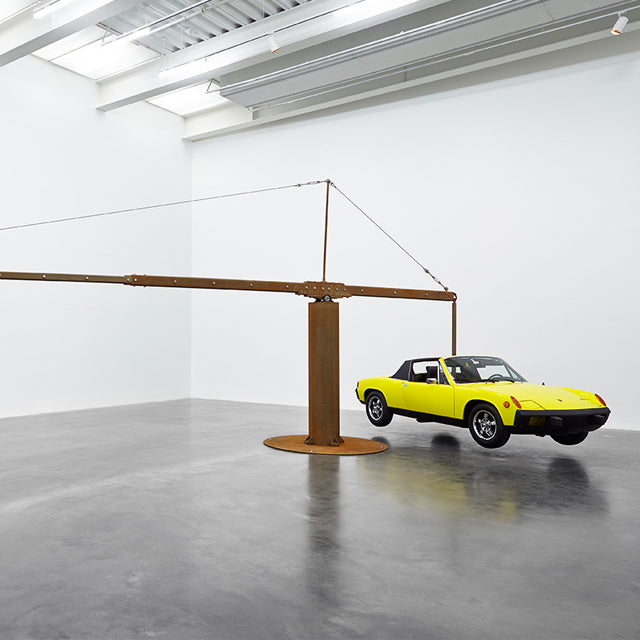Christopher “Chris” Burden (April 11, 1946 – May 10, 2015), who passed away last week, was a pioneering artist who emerged at the forefront of the art world for his early work in performance art. During a time period when performance and conceptual art seemed overly trivial and increasingly irrelevant, Burden’s work was a break with tradition because of the involvement from the artist himself.


Burden often inserted himself into his work—for his 1971 graduate thesis from art school, Burden spent five days stuffed in a book locker with a bottle of water above and a bottle for urine below. He had a friend shoot him in the arm with a .22 rifle in a work titled “Shoot.” And you can't get much more involved than crucifying yourself to the body of a Volkswagen Beetle.
The son of an engineer and a biologist, Burden was born in Boston, and became interested in visual art while recuperating from a severe scooter accident when he was an adolescent. Burden would increasingly turn to large-scale sculpture and installation as his career progressed. Arguably his most well known is “Urban Light" from 2008, a temple-shaped arrangement of restored antique street lamps on permanent view outside the Los Angeles County Museum of Art (LACMA).
But he was also enthusiastic about machines, and cars in particular—he owned a Porsche 911, and 914 amongst a few other classics like a Citroen 2CV, and even some Subaru Brats—and frequently incorporated cars, and machines into his work. Since this is Petrolicious, we’re more interested in those works.
Burden’s first automotive piece took place in Venice, California on April 23, 1974. In the performance piece,“Trans-fixed”, the artist lay on his back over the rear of a Volkswagen Beetle, and nails were driven through his palms into the body of the car. Instead of a cross, Burden is instead nailed to a Volkswagen.
The car was pushed out of the garage for the audience and the mighty four-cylinder engine revved hard for a full two minutes before being pushed back into the garage. Of “Trans-Fixed,” Burden said later, “It wasn’t an anti-car statement at all, it was a love of Volkswagens, to be honest. I had a whole bunch of them in college, and you could buy them for two or three hundred dollars.” And the nails? “…They didn’t hurt, for some reason.”
The artists’ next work featuring cars was 1977’s “B-Car”, a lightweight, operational, four-wheeled vehicle that he described as "...my fantasy as an artist of what a car should be.”
Perhaps ahead of his time, Burden purported that the B-Car should travel 100 mph, while at the same time achieving 100 mpg fuel economy. Since the vehicle was hand-made, and many of the decisions in its design and construction were based on hunches, “should” is the operative word here—not “could”.
https://www.youtube.com/watch?v=llacDdn5yIE
Even failure could be turned into art. At one time, Burden owned a freight-truck he nick-named "Big Job”, and he wanted to turn the truck into an art project. When Burden ran into various financial and legal troubles that sank the project, the artist would turn the saga into the 1977 movie Big Wrench.
The film consists of the artist addressing the audience, and telling the story of how the project was sunk, all the while holding a giant wrench, while images of the Big Job truck are projected behind him. The wrench Burden holds is the monkey-wrench that can potentially destroy any endeavor.
In 1979, Burden debuted “The Big Wheel”. He attached a 250-cc Benelli motorcycle to an antique 6000-pound iron flywheel. The flywheel is wound by the back wheel of the bike, reaching 200 rpm—about 60 miles per hour. Burden’s intentions from this piece seem to be the fusing man and machine, as if the two are indispensable to each other.
For 2011’s “Metropolis II”, the artist further expanded upon the ideas of his earlier Metropolis (2006) which featured Hot Wheels circling a mock city structure. This time, Burden would have engineer a 600-square-foot portrait of Los Angeles where 1,100 specially constructed miniature cars would navigate an intricate model track system of roads, freeways, train tracks at a speed of 240 scale mph It took four years to build and cost Burden $2.5 million. Burden said the piece is both utopian and dystopian, "there are no slums, it’s all high-rises…and, it's very fast. For me, that's what the optimism is.”
One of the artist’s last pieces was 2013’s Porsche With Meteorite. A bright yellow, and restored 1974 Porsche 914 is suspended from one end of a telescoping beam, and a small, 365-pound meteorite is hung on the other. The artist manages to balance both, with the heavier Porsche positioned closer to the center post. The effect is two bodies in complete harmony and suspension with one another.
Burden was the creator of dozens of other works, some of which can still be seen on display in major museum’s collections. Whether or not you like them, I think we can all agree that they are polarizing, if not downright interesting.
However, If you like art, and cars, you’ll surely find something stimulating about Chris Burden’s work.





Image Sources: tumblr.com, fastcodesign.com, nyogalleristny, magasin3.com, nyogalleristny, .artsjournal.com, centrevox.ca




















































